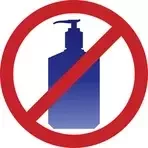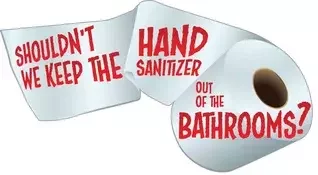
Not As Funny In Real Life
This is the time of year when it seems that everyone is sick, some with cold and flu, but many with gastrointestinal illnesses. These are the types of diseases that are spread from person-to-person via the dreaded fecal-oral route (YUCK) and require actual hand WASHING with soap and water to best prevent the spread of infection.

Soooooo, ever see hand sanitizer in a public restroom????
To illustrate a point, do you remember the movie “Stand By Me” in which the main character, Will Wheaton tells a story about a “complete and total barforama” during which “girlfriends barfed on boyfriends, kids barfed on their parents, moms barfed on dads”, etc.? (1)

Recently watching this again and laughing, I was reminded of a time when I got to witness a “complete and total barforama” first hand, and it wasn’t so funny.
A few years ago, I had the privilege of chaperoning a high school band field trip. On our last night, all 150 or so of us ate dinner then boarded the four busses to make the 24-hour trip home.
Unfortunately, it was only a couple of hours before several of the students and some of the parents were stricken with stomach cramps, vomiting, and diarrhea.
As the night and next morning unfolded, seemingly half of the people on the trip were violently writhing, puking, and pooping.
This continued to the point that we stopped at a small community hospital in Pennsylvania and were treated somewhat like a mass casualty!
Almost a third of the trip participants were admitted to the ER and given IV fluids and/or antiemetics.
After a six-hour delay, the hospital sent us home armed with sublingual zofran to be given hourly at the first sign of vomiting, and a large stack of basins in case the zofran didn’t work.
The local big-box store donated Gatorade, and we were finally on our way, still ill, but at least making progress toward home.

You have probably already guessed that the diagnosis was norovirus, picked up somewhere during the trip and easily spread based on the close quarters in the hotel and bus.
Assumedly, a food preparer at one of the restaurants we visited along the way was sick and didn’t wash hands properly and— BANG!—just like that, the trip crumbled into insidious illness that wreaked (and reeked) havoc on the ride home.
After this experience, I began to notice the large number of public restrooms that had hand sanitizer hanging on the walls, including restrooms in hospitals.
Although continual improvements to hand sanitizer effectiveness are being made, the current CDC recommendations are clear about what constitutes acceptable hand hygiene: sanitizer vs. actual hand washing.
The CDC asserts that soap and water are more effective at

removing/inactivating germs such as Cryptosporidium (2), norovirus (3), and Clostridium difficile (4), (to name a few) all of which are spread via the fecal-oral route necessitating that individuals WASH hands after using the restroom.
The CDC does say that if soap and water aren’t available, hand sanitizer is the
next best thing. Which leaves me to ponder, in the icon of hand sanitizer bottle with a red cross through the middlecase of public restrooms, especially those in hospitals, aren’t we giving healthcare workers, patients, and visitors misinformation by even having hand sanitizer available inside the restroom?

It’s not that all cases of norovirus will cause the proverbial “complete and total barforama,” but don’t we want to protect our patients and ourselves from even a SINGLE horrible episode?

Shouldn’t we keep the hand sanitizer OUT of the bathrooms so that staff and visitors remember to WASH their hands after using the restroom?
References:
- Reiner, R. (Director). (1986). Stand by Me [Motion picture]. United States: Columbia Pictures
- http://www.cdc.gov/parasites/crypto/index.html
- http://www.cdc.gov/norovirus/index.html
- http://www.cdc.gov/HAI/organisms/cdiff/Cdiff_infect.html
